
When a tiger dies, it leaves its skin; when a person dies, they leave their name. Likewise, when a pine tree dies, it leaves behind something known as gwan-sol in Korean.
When a pine tree breaks in strong winds or is cut down, it releases a sticky substance called resin. Just like how blood clots and new skin grows when a person is wounded, the resin protects and heals the tree. Over time, as the tree dies, the resin soaks into the wood and hardens—this hardened, resin-rich wood is what’s called gwan-sol.
Gwan-sol is denser and harder than ordinary pine, with more defined growth rings and a strong fragrance due to its high phytoncide content—much higher than that of cypress trees. Its oily resin makes it highly flammable and resistant to wind, so before petroleum was common, it was used as kindling or for torches. It’s also naturally resistant to bacteria and pests, which means it doesn’t decay even after many years.
Though the outer bark may rot away, gwan-sol remains intact for centuries. It’s a rare and precious product found in pine trees that have quietly endured the harshness of time—carrying the marks of pain, yet standing the test of time.